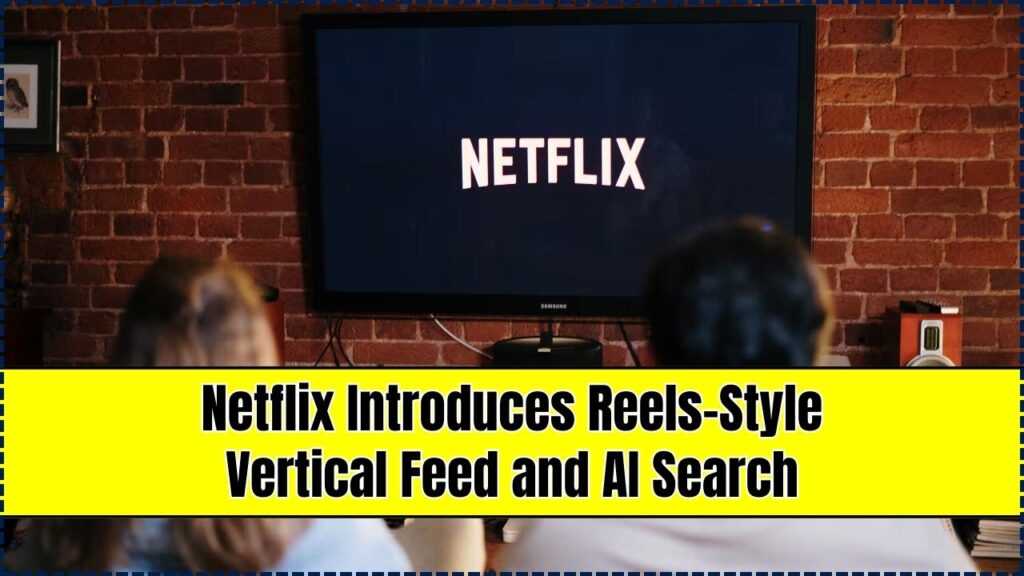Netflix Introduces Reels-Style Vertical Feed and AI Search:Netflix is bringing transformative updates to its platform that aim to completely reshape how users discover and interact with content. The latest additions—a TikTok-inspired vertical video feed and an AI-powered conversational search tool—are designed to make finding the perfect show or movie not only faster and easier but also far more engaging. These innovations are part of a larger strategy to stay competitive in the fast-evolving streaming landscape while meeting the needs of modern, digitally native viewers.

Both features reflect the massive influence that social media behavior and generative AI technologies have on how we consume media. In an era where attention spans are shorter and user expectations are higher, Netflix is pushing forward to offer a seamless, intelligent, and user-first experience that sets a new standard for the industry.
Netflix Introduces Reels-Style Vertical Feed and AI Search
| Feature | Details |
|---|---|
| New UI Features | Reels-style vertical feed, AI-powered conversational search |
| Rollout Platforms | Mobile app (vertical feed), iOS (AI search in beta) |
| Functionality | Short-form previews, natural language search queries |
| Influenced By | TikTok, Instagram Reels, ChatGPT |
| Global Rollout | Phased over several weeks/months |
| Official Source | Netflix.com, The Verge |
With the launch of a Reels-style vertical preview feed and a powerful AI-driven search tool, Netflix is redefining what it means to explore, discover, and enjoy digital content. These innovations mark a strategic shift from passive content browsing to active, intelligent, and delightful interaction.
As these tools roll out globally, Netflix isn’t just making streaming more entertaining—it’s making it more human. Whether you’re a casual viewer looking for something quick or a cinephile in search of hidden gems, the platform’s new tools ensure you’ll find what you need faster, smarter, and with less effort than ever before.
What Is the Reels-Style Vertical Feed?
Netflix’s new vertical video feed offers a swipe-friendly experience that feels familiar to anyone who uses TikTok or Instagram Reels. It’s designed to be more engaging and accessible than traditional horizontal lists or static thumbnails. The feed curates dynamic, full-screen short clips of shows, movies, documentaries, and specials that viewers can explore by simply swiping up.
How It Works:
- Curated short-form content based on your watch history
- Swipe vertically to browse trailers, moments, and scenes
- Easily save to list, watch full title, or share with friends
This type of content discovery is particularly useful for users who don’t have something specific in mind but are open to browsing based on mood or genre. According to The Verge, early beta versions show promising levels of interaction, especially among younger viewers.
AI-Powered Search: Smarter, Conversational Recommendations
Netflix is also introducing a generative AI-powered search tool that enables users to search for content using natural language. This means you can type requests like:
- “I want something light-hearted and short for a lunch break”
- “Find me a gripping drama with strong female leads”
- “Suggest a fun science show for kids”
The AI parses these conversational prompts to deliver results that go beyond mere keyword matches. It considers mood, tone, context, and previous behavior to offer smarter, more intuitive recommendations.
Key Benefits:
- Eliminates search fatigue with natural language inputs
- Brings up lesser-known titles that match nuanced preferences
- Learns over time, adapting to your content behavior
Initially rolling out on iOS in beta, this AI tool is expected to expand across platforms, and future versions may integrate voice search or even predictive suggestions. As TechCrunch reports, Netflix is investing heavily in this feature as a core pillar of its UI/UX strategy.
Why It Matters: The Future of Streaming Is Here
These changes signify more than just new bells and whistles. They mark a fundamental shift in how content is served and consumed:
- TikTok changed content discovery through short, visual storytelling—Netflix is adapting that same model to its vast content library.
- Generative AI like ChatGPT and Google Bard are transforming how users interact with digital platforms—Netflix is making that leap in entertainment.
The implications are vast. We’re moving from a passive experience (browse, scroll, play) to an interactive, adaptive, and even predictive system. As a result, users can:
- Find content faster
- Discover shows they never knew existed
- Save time deciding what to watch
This means more watch time, better user retention, and increased satisfaction for subscribers.
Netflix Introduces Reels-Style Vertical Feed and AI Search Use Netflix’s New Features
1. Explore the Vertical Feed
- Open the Netflix mobile app
- Tap on the Shorts, Previews, or For You tab (label may vary)
- Swipe vertically to scroll through clips
- Tap to view full video, add to watchlist, or share with contacts
This tool is especially effective when you’re unsure of what to watch, offering quick visual context without commitment.
2. Try the AI Search
- On your iOS device, open Netflix and tap on the search bar
- Type in plain language what you’re in the mood for
- Browse through highly relevant, tailored suggestions
- Click to view trailers, save, or watch
Netflix recommends updating the app regularly to ensure compatibility and access to the latest features.
Additional UI Enhancements: Streamlined and Smart
In tandem with these major feature launches, Netflix is also rolling out a redesigned TV interface focused on usability and navigation efficiency. According to Reuters, this revamp targets both first-time and long-term users alike.
Major Updates Include:
- Top Navigation Bar: A cleaner layout that brings Home, Shows, Movies, Games, and My List to the top of the screen
- Dynamic Content Rows: Content reorders in real time based on user actions like lingering, previews watched, or skipped content
- Contextual Badging: Badges such as “Top 10 Today”, “Critics’ Pick”, and “Trending Now” help inform choices without extra clicks
Together, these upgrades foster a faster, frictionless browsing experience, especially on Smart TVs and gaming consoles.
Industry Impact: Raising the Bar for UX Innovation
Netflix isn’t just following trends—it’s setting them. With these changes, the platform is establishing a new gold standard for user experience in the streaming space. Here’s what that could mean going forward:
- Competitors like Disney+, Max, and Amazon Prime may accelerate their own AI search and short-form strategies
- Developers may explore cross-platform compatibility with wearable tech and smart home devices
- Viewers will increasingly expect customization, voice input, and visual-first discovery as standard features
In short, Netflix is leading the charge into a world where streaming is both smart and intuitive, powered by the best of machine learning and modern design.
Top 5 AI Interview Tools in 2025 That Could Instantly Land You a Job
TCS Unveils GenAI Agentic — A New AI Tool to Help Enterprises Modernize Systems Faster
AI Models Could Soon Generate Dangerous Content — Is the Tech Industry Prepared?
FAQs On Netflix Introduces Reels-Style Vertical Feed and AI Search
Q1: Is the vertical feed available worldwide?
A: No, it’s being rolled out in phases, starting in North America and selected international markets.
Q2: Do I need to upgrade my plan for these features?
A: No. Both the vertical feed and AI search are included in all existing plans at no extra charge.
Q3: Can I opt out of AI features?
A: Not currently, though Netflix has hinted at more customization controls in future updates.
Q4: Will AI search be available via voice?
A: Voice input is being tested internally and may be introduced in a future rollout.
Q5: Is this available on web or desktop apps?
A: At the moment, AI search is limited to iOS mobile devices, but support for more platforms is on the roadmap.
Q6: How often does the AI update recommendations?
A: Recommendations adapt dynamically based on new inputs, recent activity, and evolving patterns over time.









